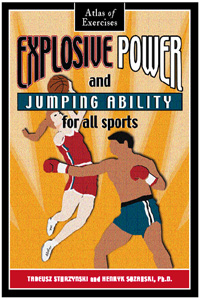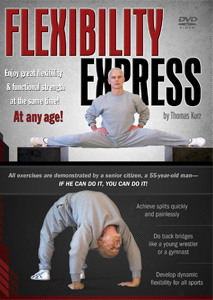by Thomas Kurz
In this installment on sports skills and strength training, you will learn how to develop explosive strength and how to select plyometric exercises.
Explosive strength can be developed by very fast movements against resistance. These movements can be standard resistance exercises such as squats or arm exercises with barbell (very fast, though), or jumps, including depth jumps, usually without additional resistance beyond that of your own body weight.
Fast lifts stress your body less than plyometrics and thus you should use them most in your work on explosive strength. In the previous installment of this article (Sports Skills and Strength Training, Part III) this matter is explained in depth. In that issue also you can learn how to decide which of these two types of exercises is right for you.
Many years’ experience developing explosive strength for jumps through squats and half-squats with a barbell shows that the greatest effects were obtained when the athlete did them very fast in sets of 5 or 6 repetitions. To ensure sufficient speed of movements, these sets were done within strictly determined time limits. It also turns out that such a program of exercises positively influences strength-endurance and sport-specific endurance.
Three effective methods of setting time limits, tested in practice, are recommended by the authors of Explosive Power and Jumping Ability for All Sports. These methods are used to control training load and program its intensification.
1. The first method uses three zones of duration for one set of exercises. These zones are slow zone, from over 11.0 to 14.5 seconds; medium speed zone, from over 8.5 to 11.0 seconds; and fast zone, from 6.5 to 8.5 seconds.
Exercises are done in sets of 5 repetitions, starting with an initial weight equal 50% of one’s maximum, and then increasing the weight in each next set.
The coach can extend a zone’s duration by one second (1 s) if the weight is very heavy.
In the preparatory period, intensification of work during a workout is based on moving from a slower zone on to the faster, when the athlete’s improved shape warrants it. For example, the athlete can move from the slow zone to the medium speed zone, or from the medium to the fast zone, or through all three zones in succession. If the duration for the zone is exceeded, the work with this exercise stops. In this manner every athlete performs work according to his or her individual capability of maintaining the assigned intensity.
2. The second method is based on determining intensity individually for each athlete, for each subperiod of the preparatory period. An initial trial is conducted at the beginning of an annual or semiannual training cycle. The timed trial consists of 5 or 6 squats or half-squats with 50% of the athlete’s maximum weight, at maximal speed. To the obtained time, one second is added. Practical experience shows that adding one second to that time usually ensures proper performance of at least six sets of the given exercise in a workout. During a workout, the weight of the barbell is increased but the duration for the set is not changed. If the duration is exceeded, the work with this exercise stops in this workout. The athlete’s task is to increase the number of sets of the exercise. If the athlete does not manage an increase during a given workout, he or she will attempt to do so during the next one.
3. The third method is based on determining an individual intensity for each athlete during each workout. Norms for intensity are determined by measuring maximal speed in performing the first set of squats before the main part of each workout. For example, a set of five repetitions with a barbell weighing 60 kg (132 lb.) took 5.95 seconds during the first workout. After adding a one-second margin, a time limit of 6.95 seconds was established for performing a set of five repetitions of squats during this workout. If the athlete exceeded this set limit, he or she stopped any further performance of these squats. During the next workout, the new time limit for this exercise is determined in the same way.
Examples of poundages used in these three methods by various athletes are shown in Explosive Power and Jumping Ability for All Sports.
At the same time you perform standard resistance exercises with time limits as just described, you can do plyometrics. You gradually increase the amount and intensity of plyometrics at the expense of other resistance exercises as you approach your competitive season.
In selecting your plyometrics, you need to be guided by the knowledge that jumps are done differently in different sports. Track-and-field’s high jump, long jump, and triple jump use heel-to-toe push-offs while ball games or martial arts do not. This is because fighters and ball players often jump in reaction to unexpected situations, not after a prerun of many steps like track-and-field jumpers. For this reason track-and-field jumpers need to do heel-to-toe push-off exercises and ball players do not.
In selecting plyometric exercises, use two criteria: their similarity to movements in your sport and their difficulty. Exercises that closely reproduce the form and dynamics of your sports action may be difficult and require gradual preparation by simpler or less strenuous plyometrics. For example, before attempting bouncing push-ups with your feet supported a foot or more above the floor, you need to do bouncing push-ups with your feet on the floor. Before attempting depth jumps, you need to prepare yourself by starting with simple bounding exercises and gradually progressing to more demanding ones.
Before doing complex plyometric exercises you may need to prepare yourself with simpler exercises that let you perfect the crucial components of the complex exercises one at a time. Progressions of plyometric exercises are shown in the book Explosive Power and Jumping Ability for All Sports: Atlas of Exercises.
In Part V of “Sports Skills and Strength Training” you will learn about importance of form and timing of movement in sport-specific strength exercises.
References
Starzynski, T. and Sozanski, H. Explosive Power and Jumping Ability for All Sports: Atlas of Exercises. Island Pond, VT: Stadion Publishing, 1999.
This article is based on the book Explosive Power and Jumping Ability for All Sports: Atlas of Exercises. Get it now and have all of the info—not just the crumbs! Order now!
If you have any questions on training you can post them at Stadion’s Sports and Martial Arts Training Discussion Forum



